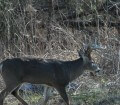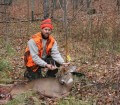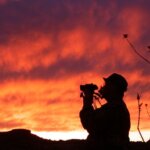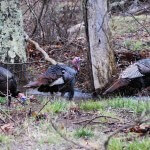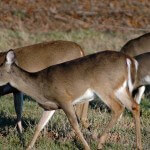John’s Note: Between the cover where they bed down, and the places where they feed, trophy-rack bucks are on the move and vulnerable, especially early in the morning and late in the afternoon. You can identify the places they prefer to be and take more deer.
 One of the most-overlooked reasons for a deer to be on the move from one location to another is hunting pressure. Deer, like most other animals, are trainable. A friend of mine utilized this knowledge to take three trophy bucks in a recent season. Every Saturday that Leroy Collins’ hunting club met to have a deer drive, they hunted the land the same way each time. Toward the end of hunting season, their deer drives produced fewer and fewer bucks. However, those who stalked and hunted the land during the week saw big antlered deer slipping through thick cover.
One of the most-overlooked reasons for a deer to be on the move from one location to another is hunting pressure. Deer, like most other animals, are trainable. A friend of mine utilized this knowledge to take three trophy bucks in a recent season. Every Saturday that Leroy Collins’ hunting club met to have a deer drive, they hunted the land the same way each time. Toward the end of hunting season, their deer drives produced fewer and fewer bucks. However, those who stalked and hunted the land during the week saw big antlered deer slipping through thick cover.
Collins decided that, “The bucks must be leaving from the cover prior to our beginning the hunt.” Acting on this assumption Collins chose to stand on the back side of the woods for several Saturdays and wait for daylight. According to Collins, one Saturday hunt was scheduled to begin at 8:00 am. “Around 7:00 am, hunters started arriving in their pick-up trucks with yapping dogs and loud mouths. When the car doors slammed, and the laughter at jokes echoed through the woods, I started seeing deer slipping out of cover. Those smart whitetails knew exactly what was happening. By 7:30 am I had a nice 8 point well within range.” Then for three consecutive Saturdays Leroy bagged big deer that the unknowing hunters had trained to leave before the hunt began, due to hunting pressure.
On most public-hunting lands, after the first few days of hunting season, the hunters there have trained the deer to move during certain periods of the day. For instance, deer will move just before daylight, because that’s the time when hunters are moving. Then when daylight arrives, the deer often will bed down. About 11:00 am, many hunters will leave the woods to return to their vehicles for lunch. By noon, most hunters are out of the woods, and the deer can move from mid-day until 2:00 or 3:00 pm when the hunters return. At mid-afternoon, deer usually will be down or head for thick cover, until the hunters leave the woods about 45 minutes before dark.
 With this information, a hunter can set-up several tactical game plans utilizing hunting pressure, which will lead a buck deer to him. Knowing the deer will move to thick cover at daylight, and most of the sportsmen will be where they can see a long way, the wise woodsman will move into thick cover, get high in a tree and have limited visibility of maybe no more than 10-20 yards. But knowing the bucks will move away from the pressure into the cover, this sportsman will have a better chance of taking a whitetail than the ridge sitters who have a view of 200-400 yards. Too, the mid-day hunter – the one who goes into the woods at 10:00 am and takes a stand on the edge of heavy cover until 2:00 pm – may see more deer than the early or late hunters. Finally the hunter who is not afraid to walk out of the woods after dark may be able to sight in on a trophy buck in the last 10 minutes of light when the deer are moving, and the rest of the hunters are headed to their houses.
With this information, a hunter can set-up several tactical game plans utilizing hunting pressure, which will lead a buck deer to him. Knowing the deer will move to thick cover at daylight, and most of the sportsmen will be where they can see a long way, the wise woodsman will move into thick cover, get high in a tree and have limited visibility of maybe no more than 10-20 yards. But knowing the bucks will move away from the pressure into the cover, this sportsman will have a better chance of taking a whitetail than the ridge sitters who have a view of 200-400 yards. Too, the mid-day hunter – the one who goes into the woods at 10:00 am and takes a stand on the edge of heavy cover until 2:00 pm – may see more deer than the early or late hunters. Finally the hunter who is not afraid to walk out of the woods after dark may be able to sight in on a trophy buck in the last 10 minutes of light when the deer are moving, and the rest of the hunters are headed to their houses.
The weather man may provide the best information for hunting when the hunting pressure is at its lowest ebb. Most outdoorsmen won’t go deliberately to the woods when they know bad weather is coming. However, sometimes deer will feed and move more frequently ahead of a storm front than any other time. For the hunter willing to brave the weather, he or she may spot a big buck just ahead of an impending weather change. Once the storm does hit, the fair weather hunter definitely won’t go into the woods. But this may be the most-opportune time for you to find your big buck for the season. Briar thickets, blown-down treetops and any other type of heavy cover may provide a refuge for the whitetail during the storm.
“By walking up to a downed treetop and standing there looking at the treetop for a long time, a hunter often can see a deer in the bed,” Edwin Hitt of Laurel, Mississippi, explains. “Even if you don’t spot the deer, but he sees you, he’ll get so nervous, he’ll start to quiver. Finally he’ll bolt from cover and you can take him.”
 For many sportsmen, meeting deer is a chance happening. And, the odds are most often in the deer’s favor. However by understanding deer, their movements, their habitat and the effects of pressure on them, hunters can more accurately determine where to meet nice bucks.
For many sportsmen, meeting deer is a chance happening. And, the odds are most often in the deer’s favor. However by understanding deer, their movements, their habitat and the effects of pressure on them, hunters can more accurately determine where to meet nice bucks.
To get John E. Phillips’ Kindle eBooks and print books on hunting deer, “How to Hunt and Take Big Buck Deer on Small Properties,” “How to Hunt Deer Up Close: With Bows, Rifles, Muzzleloaders and Crossbows,” “PhD Whitetails: How to Hunt and Take the Smartest Deer on Any Property,” “How to Take Monster Bucks,” “How to Hunt Deer Like a Pro,” and “Bowhunting Deer: Mossy Oak Pros Know Bucks and Bows,” or to prepare venison, “Deer & Fixings,” click here.
For information on making jerky from your deer to provide a protein-rich snack, you can download a free book from https://johninthewild.com/free-books.

